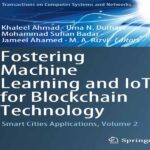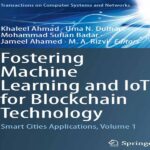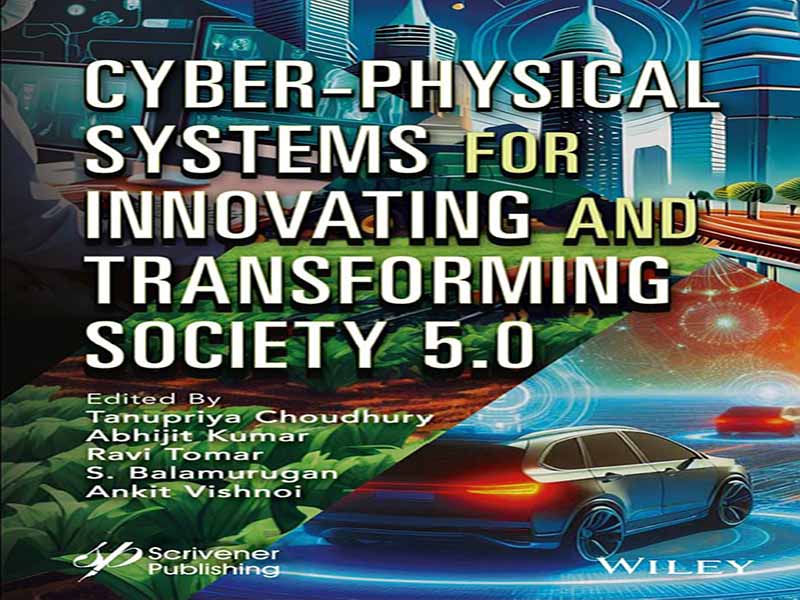- عنوان کتاب: Cyber-Physical Systems for Innovating and Transforming Society 5.0
- نویسنده: Choudhury, TanupriyaKumar, AbhijitTomar
- حوزه: سایبر فیزیک
- سال انتشار: 2025
- تعداد صفحه: 377
- زبان اصلی: انگلیسی
- نوع فایل: pdf
- حجم فایل: 18.6 مگابایت
این کتاب پیشرفتها را در حوزههای مختلف Society 5.0 از طریق فناوریهای پیشرفته بررسی میکند. این بینش ها، برنامه ها و پیاده سازی های جامع و پیشرفته را ارائه می دهد که برای بهره مندی از بخش های مختلف اجتماعی طراحی شده اند. این کتاب که حوزههای چند رشتهای مانند چارچوبهای قانونی، مراقبتهای بهداشتی، جامعه هوشمند، سیستمهای فیزیکی-سایبری و کشاورزی هوشمند را پوشش میدهد، دارای مشارکتهای متخصصان در هر زمینه است و هر فصل بهطور دقیق بررسی شده است. این منبع با هدف پژوهشگران و دانشگاهیان، کاوش ایدهها، تکنیکها و ابزارهای جدید را تسهیل میکند. این کتاب به سیستمهای فیزیکی-سایبری (CPS) برای جامعه نوآورانه 5.0 میپردازد و از فناوریهای مخرب استفاده میکند. مفهوم CPS و کاربردهای آن در حوزه های مختلف از جمله تولید، انرژی، حمل و نقل، مراقبت های بهداشتی و کشاورزی را معرفی می کند. علاوه بر این، آخرین روندهای تحقیقاتی در CPS را بررسی می کند و بینش هایی را در مورد آینده جوامع هوشمند دارای CPS ارائه می دهد. یک سیستم فیزیکی-سایبری (CPS) شبکهای از موجودیتهای فیزیکی و محاسباتی است که برای به اشتراک گذاشتن دادهها و بازخورد تعامل دارند و امکان یکپارچهسازی یکپارچه سیستمهای سایبری با دنیای فیزیکی را فراهم میکنند. این ادغام از طریق فناوریهای مخرب به توسعه یک جامعه «هوشمند» 5.0 کمک میکند. CPS را می توان در صنایع مختلف مانند حمل و نقل، انرژی، مراقبت های بهداشتی و تولید به کار برد. با تقویت ارتباط بین دستگاه ها و انسان ها، CPS تصمیم گیری سریع تر و کارآمدتر را امکان پذیر می کند. به عنوان مثال، نظارت بر زمان واقعی الگوهای ترافیک به مقامات حمل و نقل اجازه می دهد تا جریان ترافیک را بهینه کرده و ازدحام را کاهش دهند، در حالی که بیمارستان ها می توانند مراقبت از بیمار را با ردیابی علائم حیاتی و برنامه های دارویی در زمان تقریباً واقعی بهبود بخشند. با ظهور فناوری نوآورانه، ما در آستانه عصر جدیدی هستیم که در آن ماشینها به طور یکپارچه با هم ارتباط برقرار میکنند و راه را برای جامعه کارآمدتر و هوشمندتر 5.0 هموار میکنند. این مجموعه دارای مجموعه گسترده ای از آثار علمی است که بینش های دقیقی را در زمینه هایی مانند پردازش تصویر، پردازش زبان طبیعی، بینایی کامپیوتری، تجزیه و تحلیل احساسات، و همچنین تشخیص صدا و ژست ها، در میان سایر زمینه های مرتبط ارائه می دهد. این متن رویکردهای بین رشتهای را در بر میگیرد که چارچوبهای قانونی، سیستمهای پزشکی، توسعه هوشمند شهری، زیرساختهای سیستمهای فیزیکی-سایبری یکپارچه و شیوههای کشاورزی پیشرفته را پوشش میدهد. که توسط متخصصان این رشته ها تالیف شده است، هر بخش برای اطمینان از کیفیت و دقت مورد بررسی دقیق قرار گرفته است. این نشریه در درجه اول برای محققان و متخصصان دانشگاهی که به دنبال پارادایمها، روششناسی و ابزارهای جدید هستند، طراحی شده است، هدف این نشریه این است که به عنوان یک کاتالیزور برای پیشرفت تحقیقات مربوط به سیستمهای فیزیکی-سایبری برای یک جامعه نوآور 5.0 خدمت کند. در نهایت، جاهطلبی محرک این کار جمعآوری و انتشار دانش جمعی در مورد فناوریهای انقلابی است که سفر ما را به سوی جامعهای به هم پیوستهتر و هوشمندتر شکل میدهند. فصل 1 به بررسی پیشرفتها در ایجاد انقلاب در عملیات حقوقی و بهترین شیوهها، بحث در مورد تکنیکهای نوآورانه برای مدیریت پرونده، کنترل قرارداد، مدیریت اسناد، تحقیقات حقوقی، و پشتیبانی دعاوی میپردازد. این نشان میدهد که چگونه الگوریتمهای هوش مصنوعی به طور فزایندهای وظایفی را که به طور سنتی توسط انسان انجام میشود، خودکار میکنند. فصل 2 قابلیتهای دستیار صوتی را در حوزههای مختلف، مانند توصیههای شخصیسازی شده، پیشبینی آب و هوا، و یادآوریهای فعال بررسی میکند. در فصل 3، نویسندگان به طور کامل پیچیدگیهای رایانش ابری و نقش محوری آن در غلبه بر چالشها و استفاده از فرصتهای درون متاورس را بررسی میکنند. آنها بر این نکته تأکید میکنند که چگونه ادغام فناوریهای ابری در سیستمهای فیزیکی-سایبری، کسبوکارها را قادر میسازد تا در این چشمانداز تعاملی پیشروی کنند. فصل 4 بر فناوری های معاصر برای تشخیص و کنترل زودهنگام چاله ها و آتش سوزی ها تمرکز دارد. این برنامه استفاده از وسایل نقلیه هوایی بدون سرنشین را برای ضبط فیلم از کنار جاده ها با برنامه های مبتنی بر هوش مصنوعی با استفاده از شبکه های عصبی مصنوعی برای شناسایی و شناسایی چاله ها و خطرات آتش سوزی معرفی می کند. فصل 5 تأثیر هوش مصنوعی (AI) و رباتیک را بر افزایش امنیت سایبری و بخش های مراقبت های بهداشتی بررسی می کند. ادبیات نشان می دهد که کاربرد هوش مصنوعی در این زمینه ها در حال ظهور است و پتانسیل قابل توجهی برای تحقیقات آینده ارائه می دهد. فصل 6 راهبردهایی را برای آزمایش کنترل شده برای اطمینان از انطباق با استاندارد ایمنی، پیشنهاد معیارهای مبتنی بر اوج نیروی برخورد، بالاترین انحراف، و جذب انرژی داخلی در طول آزمایش ضربه خودرو مورد بحث قرار می دهد. فصل 7 تکنیک های تولید ماتریس کلیدی مورد استفاده در سیستم رمزنگاری هیل را پوشش می دهد. نویسنده الگوریتمی را معرفی میکند که با تمرکز بر امنیت، عملکرد، سهولت اجرا و محدودیتها در سیستمهای فیزیکی-سایبری طراحی شده است. فصل 8 یک مدل مبتنی بر یادگیری ماشینی را برای پیشبینی آهنگ Spotify پیشنهاد میکند و به بررسی این موضوع میپردازد که چگونه پلتفرمهای پخش آنلاین از ابزارها و معیارهای مختلف استفاده میکنند…
The book explores advances across various domains of Society 5.0 through cutting-edge technologies. It offers comprehensive, state-of-the-art insights, applications, and implementations designed to benefit different societal sectors. Covering multidisciplinary areas such as legal frameworks, healthcare, intelligent society, cyber-physical systems, and smart agriculture, the book features contributions from experts in each field, with every chapter rigorously reviewed. Aimed at researchers and academicians, this resource will facilitate the exploration of new ideas, techniques, and tools. This book delves into Cyber-Physical Systems (CPS) for the innovative Society 5.0, harnessing disruptive technologies. It introduces the concept of CPS and its applications across various domains, including manufacturing, energy, transportation, healthcare, and agriculture. Additionally, it explores the latest research trends in CPS and provides insights into the future of CPS-enabled intelligent societies. A Cyber-Physical System (CPS) is a network of physical and computational entities that interact to share data and feedback, enabling the seamless integration of cyber systems with the physical world. This integration contributes to the development of a “smart” Society 5.0 through disruptive technologies. CPS can be applied across multiple industries, such as transportation, energy, healthcare, and manufacturing. By enhancing communication between devices and humans, CPS enables faster and more efficient decision-making. For example, real-time monitoring of traffic patterns allows transportation authorities to optimize traffic flow and reduce congestion, while hospitals can improve patient care by tracking vital signs and medication schedules in near-real time. With the rise of innovative technology, we are on the brink of a new era where machines communicate seamlessly, paving the way for a more efficient and intelligent Society 5.0. This compilation will feature an extensive selection of scholarly works, offering detailed insights into fields such as image processing, natural language processing, computer vision, sentiment analysis, as well as voice and gesture recognition, among other relevant areas. The text will incorporate interdisciplinary approaches covering legal frameworks, medical systems, intelligent urban development, integrated cyber-physical systems infrastructure, and advanced agricultural practices. Authored by experts in these disciplines, each contribution has undergone meticulous scrutiny to ensure quality and accuracy. Primarily designed for scholars and academic professionals seeking novel paradigms, methodologies, and tools, this publication aims to serve as a catalyst for advancing research related to Cyber-Physical Systems for an Innovative Society 5.0. Ultimately, the driving ambition behind this work is to aggregate and disseminate collective knowledge on revolutionary technologies that are shaping our journey toward a more interconnected and intelligent society. Chapter 1 explores advancements in revolutionizing legal operations and best practices, discussing innovative techniques for case management, contract control, document management, legal research, and litigation support. It highlights how AI algorithms are increasingly automating tasks traditionally handled by humans. Chapter 2 examines voice assistant capabilities across various domains, such as personalized recommendations, weather forecasting, and proactive reminders. In Chapter 3, the authors thoroughly explore the complexities of cloud computing and its pivotal role in overcoming challenges and seizing opportunities within the metaverse. They emphasize how integrating cloud technologies into cyber-physical systems enables businesses to navigate and excel in this interactive landscape. Chapter 4 focuses on contemporary technologies for early detection and control of potholes and fires. It introduces the use of unmanned aerial vehicles to capture footage of roadsides, with AI-based programs utilizing artificial neural networks to detect and identify potholes and fire hazards. Chapter 5 investigates the impact of artificial intelligence (AI) and robotics on enhancing cybersecurity and healthcare sectors. The literature suggests that AI’s application in these fields is emerging and offers substantial potential for future research. Chapter 6 discusses strategies for controlled testing to ensure safety standard compliance, proposing criteria based on peak collision force, highest deflection, and internal energy absorption during vehicle impact testing. Chapter 7 covers key matrix generation techniques used in the Hill cipher cryptosystem. The author introduces an algorithm designed with a focus on security, performance, ease of implementation, and limitations in cyber-physical systems. Chapter 8 proposes a machine learning-based model for Spotify song prediction, exploring how online streaming platforms use various tools and metrics to gauge a song’s popularity. Chapter 9 examines sentiment analysis and its role in shaping campaign strategies, including targeted messaging and crisis management. It presents several methods, case studies, and ethical considerations, highlighting AI’s growing influence in optimizing political campaigns through data-driven decision-making. Chapter 10 delves into technology’s role in enhancing learner engagement, showcasing how digital tools and platforms offer opportunities for creating interactive, personalized learning experiences. Practical examples and ethical considerations emphasize the importance of intentional technology integration in education. Chapter 11 explores the real-time integration of disruptive technologies within Cyber-Physical Systems (CPS), with a focus on directed energy weapons, autonomous systems, and AI in modern warfare. This chapter presents a framework demonstrating the transformative impact of these technologies on Defense Posture Systems (DPS) and their crucial role in reshaping military strategies.
این کتاب را میتوانید از لینک زیر بصورت رایگان دانلود کنید:
Download: Cyber-Physical Systems for Innovating and Transforming Society 5.0




































نظرات کاربران